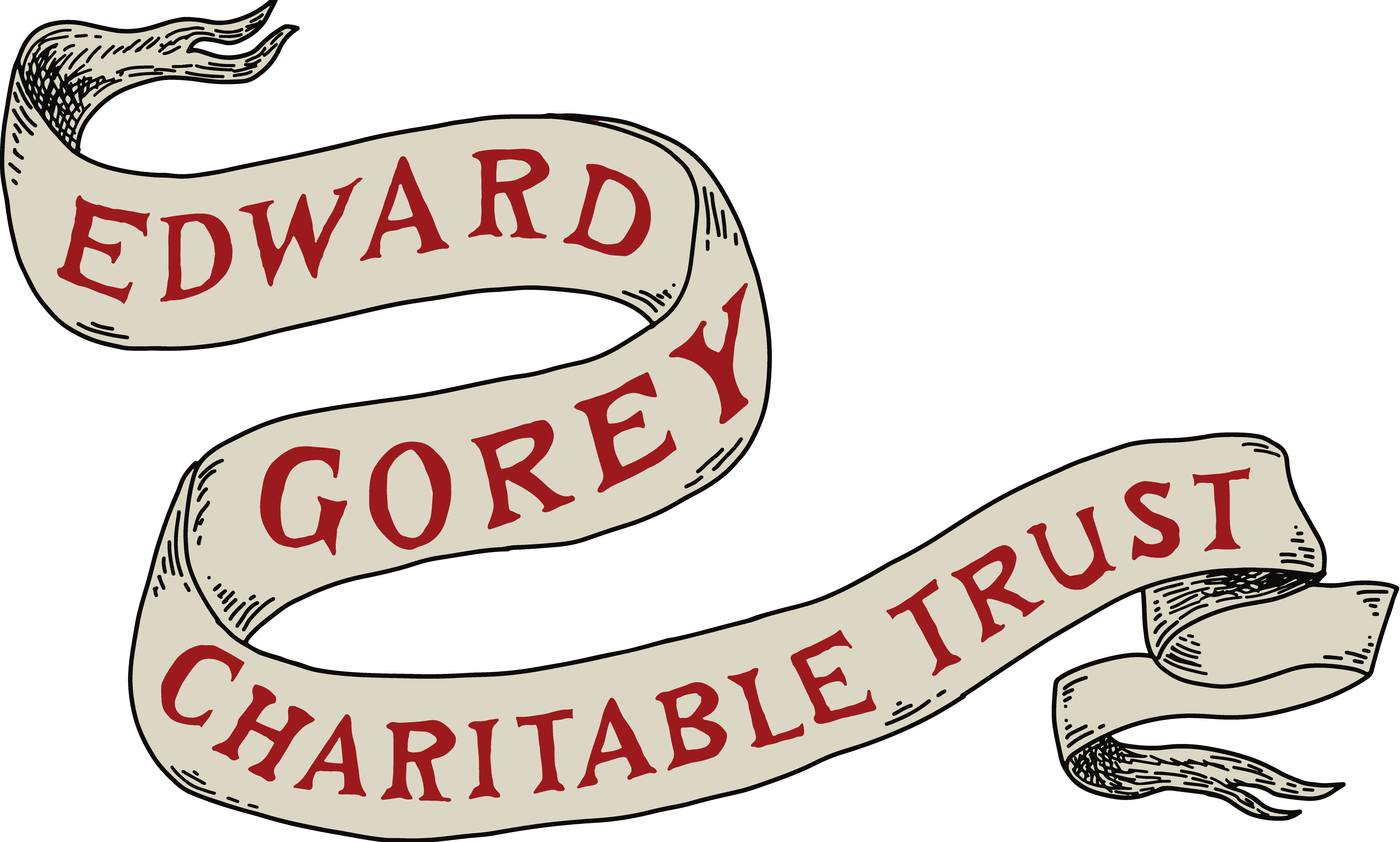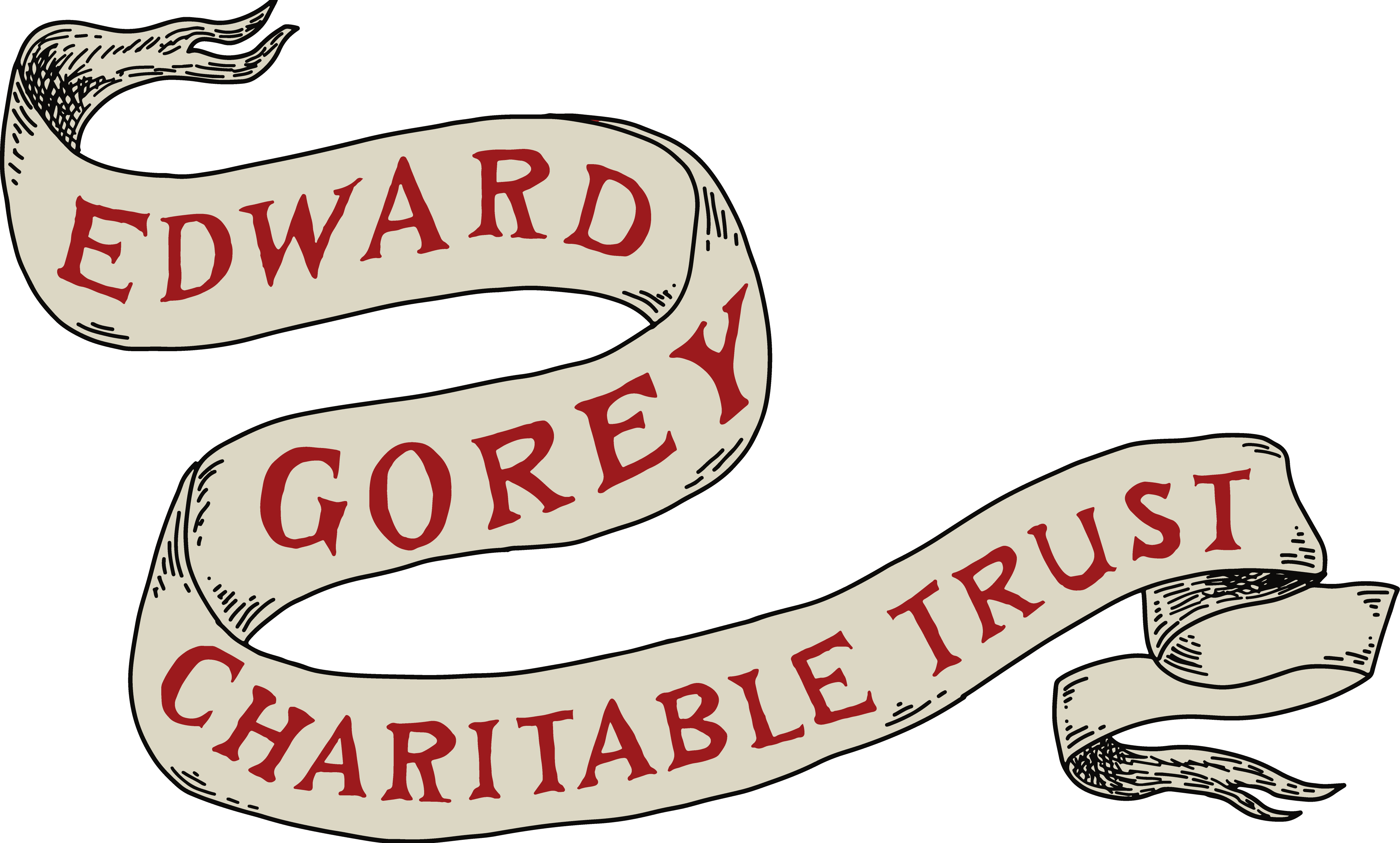By Malcolm Whyte
The Edward Gorey Charitable Trust has partnered with writer (Gorey Secrets, Great Comic Cats) and Gorey collector Malcolm Whyte to publish articles and chapters from his most recent work, Edward Gorey Tales Explored, on our Gorey Voices blog. Over the next few months, the Trust will showcase approximately 15 articles written by Mr. Whyte, each focusing on a different book by Edward Gorey. This collaboration offers a wonderful opportunity to delve deeper into Gorey’s works through the perspective of one of his most avid followers.

There is no question about The Doubtful Guest, however, it is a children’s book. Gorey created it firstly for children. The text, presented in charming two-line rhyming couplets1, is easy to follow, even with words like “flue,” “urn,” “askew,” “tureen,” and “gramophone.
On pages opposite the text, Gorey’s vividly penned Edwardian period illustrations are expressive enough by themselves to happily engage young readers throughout the book. But the Doubtful Guest is the star. An imaginative combination of a small child and a large penguin, it becomes the interminable, uninvited guest of a household that endures its rude, odd, and perplexing manner — seemingly without end.
One wintery evening, upon answering the mansion’s doorbell, the robed patriarch and family.
“… saw something standing on top of an urn, whose peculiar appearance gave then quite a turn.”
It scurried through the open door into the hall where it stopped with its nose against the wall.
The family found it still there in the morning, when
“It joined them at breakfast and presently ate all the syrup and toast, and a part of a plate.”


With that, the “Guest’s” bizarre behavior really takes off! It yanks the speaker from the
gramophone and won’t give it back. It tears whole chapters out of books, knocks pictures
askew on their hooks, hides in the enormous soup tureen, steals away all the towels from the
bath, and snatches up favorites objects only to pitch them in to the pond. In the end, the stoic
Edwardian family appears resigned to the situation, saying:
“It came seventeen years ago — and to this day it has shown no intention of going away.”
The Doubtful Guest is certainly a very mischievous creature, but not particularly harmful. It is neither as mean as Max at his tantrum worst in Sendak’s Where the Wild Things Are; as wildly
destructive as Thing One and Thing Two in Dr Seuss’s The Cat In the Hat; nor as thoughtless as Little Lulu could be while, otherwise, trying her innocent best to do well.
These outbursts of pent-up energy are universal in the young as we’ve seen in the giggling child that runs away when called for a bath or to get in the car; the more one yells at the child to stop, the faster it runs away. In addition to burning up excess energy, the fleeting child is also testing the bounds of authority.
These outbursts of pent-up energy are universal in the young as we’ve seen in the giggling child that runs away when called for a bath or to get in the car; the more one yells at the child to stop, the faster it runs away. In addition to burning up excess energy, the fleeting child is also testing the bounds of authority.
“The Doubtful Guest …was dedicated to me under my current married name, Alison Bishop. It
was inspired, more or less, by a remark I made to Ted when my first son was less than two years old. I said that having a young child around all the time was like having a houseguest who never said anything and never left. This, of course, is what happens in the story. The ‘Doubtful Guest’ appears out of nowhere. He is always there, he just sits around, and he always wears sneakers, like a child or like Ted himself. He is a child, of course, and many mothers have recognized this since the book was published.2
Lurie makes a salient point comparing the sneaker-shod Guest to Gorey, who has never been
shy about including himself in his stories, wearing his characteristic ankle-length fur coat and
canvas Keds, he appears in The Chinese Obelisks, The Glorious Nosebleed, The Lavender
Leotard, and even, in essence, in E.D. Ward, A Mercurial Bear.
The Doubtful Guest’s elongated, striped scarf presents another Gorey self-reference. This
woolen accessory was a part of the “preppy” fashion that college and university campuses
embraced in the 1950s — especially in the colder climes from the Midwest to the ivy walls of
eastern institutions. Gorey must have worn one while at Harvard, 1946-1950.

In my time at Cornell University (1951-1955), I never had such a scarf, but many passed by either wrapping a coed in a camel-hair coat, or tentatively warming a hatless young grad scurrying across the snow drifted quad dressed only in worn, low-cut tennies and grey flannel suit. I felt the accessory’s fad a bit overdone and made a macabre cartoon about it for the campus humor magazine, The Cornell Widow.
A Theory
An abridged version of Edward Gorey’s Great Simple Theory about Art states: “Anything that is art is presumably about some certain thing, but is really about something else.” Applied to The Doubtful Guest it is, on one hand, an amusing children’s fantasy, on the other, it can convey the ancient philosophy to take life as it comes; be patient; don’t force things; and accept that the cyclic nature of time will bring change when required and that nature will take
its course.
This concept is pretty sophisticated for a kid’s book and surprising coming from an artist who was just a few years out of university, but then Gorey is no ordinary artist. We see that The Doubtful Guest is a basic example of his Simple Theory of Art. Often, when asked what his art and writing mean, he dryly says,” What you see, is what you get.” What we get is a tale by an author/artist who fashioned a mysterious character, more child than beast, for a book that hints at being more than a world-loved children’s classic.
As of this writing The Doubtful Guest has been optioned by David Spielberg’s Amblin Productions, then picked up by Netflix. It’ll be a “hybrid” feature movie that uses a combination of live action and animation. No release date is set.
1. “…Gorey anapestic tetrameter, instantly familiar from ….”A Visit from St. Nicholas.” Dery, Mark, Born to be Posthumous, Little, Brown, New York, 2008, p.182 ↩
2. “Of Curious, Beastly & Doubtful Days, Alison Lurie on Edward ‘Ted’ Gorey,” Yarmouth Port, MA. October 4, 2008. ↩
3. Gorey Secrets, Whyte, Malcolm. University Press of Mississippi, 2021, Jackson, MS ↩



